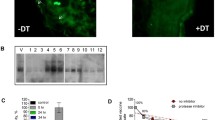Summary
To investigate the role of epidermal Langerhans cells (LC) in resistance to herpes simplex virus (HSV) infection, nonadherent spleen cells taken from BALB/c mice immunized with HSV were cultured with syngeneic epidermal cells (EC) and ultraviolet light-inactivated HSV antigen. After five days of culture, T cell-dependent proliferative response was determined by3H-thymidine incorporation. Treatment of EC with anti-Iad monoclonal antibody plus complement before cultivation prevented this proliferation, which suggested that LC induced stimulation of immune T cells. When these stimulated spleen cells were transferred to intracutaneously infected nude mice, the virus titer in the skin was reduced markedly and the formation of zosteriform skin lesions was completely inhibited. On the other hand, transfer of unstimulated cells, which were cultured with HSV antigen only or with HSV antigen and EC treated with anti-Iad monoclonal antibody plus complement, resulted in delayed viral clearance and development of the lesions. These results indicate that LC are of importance as accessory cells in the control of cutaneous HSV infection. Furthermore, Lyt 1+ T cells in the stimulated population were shown to have greater protective activity than Lyt 2+ T cells.
Similar content being viewed by others
References
Ahmann, G. B., Sachs, D. H., Hodes, R. J.: Requirement for an I a-bearing accessory cell in Con A-induced T cell proliferation. J. Immunol.121, 1981–1989 (1978).
Black, A. K., Greaves, M. W., Hensby, C. N., Plummer, N. A.: Increased prostaglandin E2 and F2a in human skin at 6 and 24 H after ultraviolet B irradiation. Br. Clin. Pharmacol.5, 431–436 (1978).
Blyth, W. A., Harbour, D. A., Hill, T. J.: Pathogenesis of zosteriform spread of herpes simplex virus in the mouse. J. gen. Virol.65, 1477–1486 (1984).
Blyth, W. A., Hill, T. J., Field, H. J., Harbour, D. H.: Reactivation of herpes simplex virus infection by ultraviolet light and possible involvement of prostaglandins. J. gen. Virol.33, 547–550 (1976).
Braathen, L. R., Bjerche, S., Thorsly, E.: The antigen-presenting function of human Langerhans cells. Immunobiology168, 301–312 (1984).
Elemets, C. A., Bergstresser, P. R., Tigelaar, R. E., Wood, P. J., Streilein, J. W.: Analysis of the mechanism of unresponsiveness produced by haptens painted on skin exposed to low dose ultraviolet radiation. J. Exp. Med.158, 781–794 (1983).
Ennis, J. A., Wells, M.: Immune control of herpes simplex virus infection. Cancer Res.34, 1140–1145 (1974).
Habu, S., Raff, M. C.: Accessory cell dependence of lectin induced proliferation of mouse T lymphocytes. Eur. J. Immunol.7, 451–457 (1977).
Harbour, D. A., Hill, T. J., Blyth, W. A.: Recurrent herpes simplex in the mouse: Inflammation in the skin and activation in the ganglia following peripheral stimulation. J. gen. Virol.64, 1491–1498 (1983).
Iwasaka, T., Sheridan, J. F., Aurelian, L.: Immunity to herpes simplex virus type 2: Recurrent lesions are associated with the induction of suppressor cells and soluble suppressor factors. Infect. Immun.42, 955–964 (1983).
Julis, M. H., Simpson, E., Herzenberg, L. A.: A rapid method for the isolation of functional thymus-derived murine lymphocytes. Eur. J. Immunol.3, 645–652 (1973).
Kammer, G. M., Unnaue, E. R.: Accessory cell requirement in the proliferative response of T lymphocytes to hemocyanin. Clin. Immunol. Immunopathol.15, 434–443 (1980).
Kino, Y., Hayashi, Y., Hayashida, I., Mori, R.: Dissemination of herpes simplex virus in nude mice after intracutaneous inoculation and effect of antibody on the course of infection. J. gen. Virol.63, 475–479 (1982).
Larsen, H. S., Feigo, M., Horohov, D. W., Moore, R. N., Rouse, B. T.: Role of T-lymphocyte subsets in recovery from herpes simplex virus infection. J. Virol.50, 56–59 (1984).
Larsen, H. S., Russel, R. G., Rouse, B. T.: Recovery from lethal herpes simplex type 1 infection is mediated by cytotoxic T lymphocytes. Infect. Immun.41, 197–204 (1983).
Mori, R., Tasaki, G., Kimura, G., Takeya, K.: Depression of aquired resistance against herpes simplex virus infection in neonatally thymectomized mice. Arch. Gesamte Virusforsch.21, 459–462 (1967).
Nagafuchi, S., Hayashida, I., Higa, K., Wada, T., Mori, R.: Role of Lyt-1 positive immune T cells in recovery from herpes simplex virus infection in mice. Microbiol. Immunol.26, 359–362 (1982).
Nagafuchi, S., Oda, H., Mori, R., Taniguchi, T.: Mechanisms of aquired resistance to herpes simplex virus infection as studied in nude mice. J. gen. Virol.44, 715–723 (1979).
Nash, A. A., Gell, P. G. H.: Membrane phenotype of murine effector and suppressor T cells involved in delayed hypersensitivity and protective immunity to herpes simplex virus. Cell. Immunol.75, 348–355 (1981).
Nash, A. A., Quariety-Papafio, R., Wildy, P.: Cell-mediated immunity in herpes simplex virus infected mice: Functional analysis of lymph node cells during periods of acute and latent infection with reference to cytotoxic and memory cells. J. gen. Virol.19, 309–317 (1980).
Oakes, J. E.: Role of cell-mediated immunity in the resistance of mice to subcutaneous herpes simplex infection. Infect. Immun.12, 166–172 (1975).
Oakes, J. E., Rector, J. T., Lausch, R. N.: Lyt 1+ cells participate in recovery from ocular herpes simplex virus type 1 infection. Invest. Opthalmol. Vis. Sci.25, 188–194 (1984).
Schmid, D. S., Larsen, H. S., Rouse, B. T.: Role of I a antigen expression and secretory function of accessory cells in the induction of cytotoxic T lymphocyte responses against herpes simplex virus. Infect. Immun.37, 1138–1147 (1982).
Simmons, S. A., Nash, A. A.: Zosteriform spread of herpes simplex virus as a model of recrudescence and its use to investigate the role of immune cells in prevention of recurrent disease. J. Virol.52, 816–821 (1984).
Stingl, G., Gazze-Stingl, L. A., Aberer, W., Wolff, K.: Antigen presentation by murine Langerhans cells and its alteration by ultraviolet B light. J. Immunol.127, 1707–1713 (1981).
Streilein, J. W., Bergstresser, P. R.: Langerhans cells: Antigen presenting cells of the epidermis. Immunobiology168, 285–300 (1984).
Wolff, K., Stingl, G.: The Langerhans cell. J. Invest. Dermatol.80, 17–21 (1983).
Author information
Authors and Affiliations
Additional information
With 1 Figure
Rights and permissions
About this article
Cite this article
Yasumoto, S., Okabe, N. & Mori, R. Role of epidermal Langerhans cells in resistance to herpes simplex virus infection. Archives of Virology 90, 261–271 (1986). https://doi.org/10.1007/BF01317375
Received:
Accepted:
Issue Date:
DOI: https://doi.org/10.1007/BF01317375




